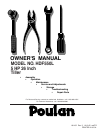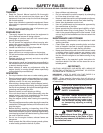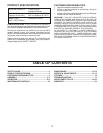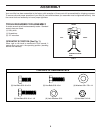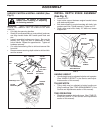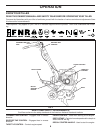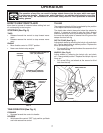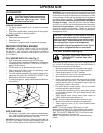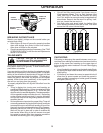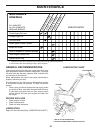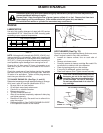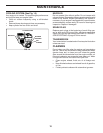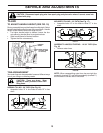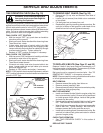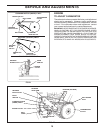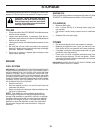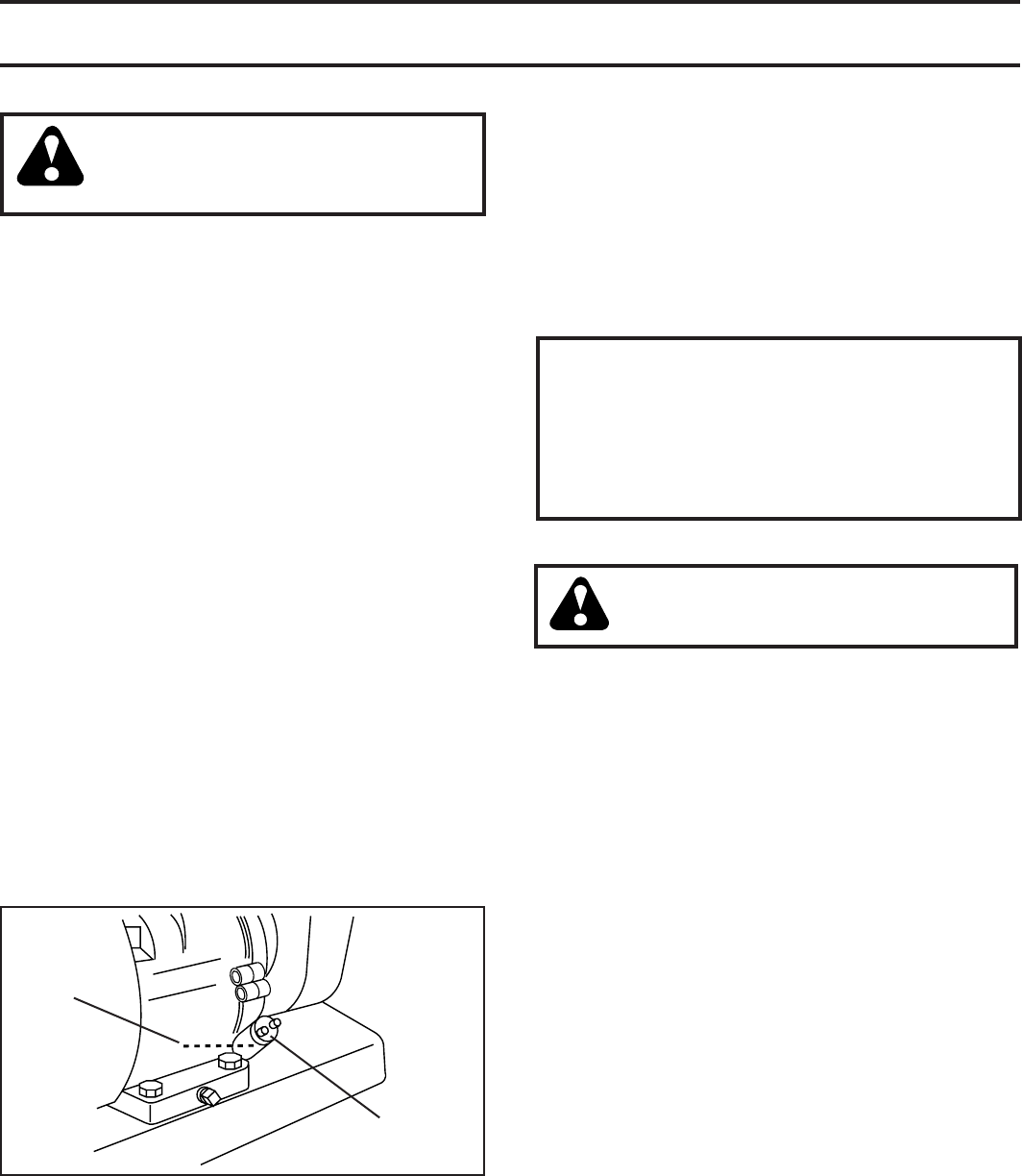
8
TO TRANSPORT
CAUTION: Before lifting or trans port ing,
allow tiller engine and muffl er to cool.
Disconnect spark plug wire. Drain
gasoline from fuel tank.
AROUND THE YARD
• Tip depth stake forward until it is held by the stake
spring.
• Push tiller handles down, raising tines off the ground.
• Push or pull tiller to desired location.
AROUND TOWN
• Disconnect spark plug wire.
• Drain fuel tank.
• Transport in upright position to prevent oil leakage.
FIG. 7
OIL
FILLER
PLUG
OIL
LEVEL
BEFORE STARTING ENGINE
IMPORTANT: BE VERY CAREFUL NOT TO ALLOW DIRT
TO ENTER THE ENGINE WHEN CHECKING OR ADDING
OIL OR FUEL. USE CLEAN OIL AND FUEL AND STORE IN
AP PROVED, CLEAN, COVERED CONTAINERS. USE CLEAN
FILL FUNNELS.
FILL ENGINE WITH OIL (See Fig. 7)
• With engine level, remove engine oil fi ller plug.
• Fill engine with oil to point of overfl owing. For ap prox-
i mate ca pac i ty see “PRODUCT SPEC I FI CA TIONS” on
page 3 of this manual.
• Tilt tiller back on its wheels and then re-level.
• With engine level, refi ll to point of overfl owing if nec-
es sary. Re place oil fi ller plug.
• For cold weather operation you should change oil for
easier starting (See “OIL VISCOSITY CHART” in the
Maintenance section of this manual).
• To change engine oil, see the Maintenance section of
this manual.
OPERATION
ADD GASOLINE
• Fill fuel tank. Use fresh, clean, regular unleaded gaso-
line. (Use of leaded gasoline will increase carbon and
lead oxide deposits and reduce valve life.)
IMPORTANT: WHEN OPERATING IN TEM PERA TURES BELOW
32°F (0°C), USE FRESH, CLEAN, WINTER GRADE GASOLINE
TO HELP INSURE GOOD COLD WEATHER STARTING.
WARNING: Experience indicates that alcohol blended fuels
(called gasohol or using ethanol or methanol) can attract
moisture which leads to separation and formation of acids
during storage. Acidic gas can damage the fuel system of
an engine while in storage. To avoid engine problems,
the fuel system should be emptied before stor age of
30 days or longer. Drain the gas tank, start the engine
and let it run until the fuel lines and carburetor are empty.
Use fresh fuel next season. See Storage section of this
manual for additional information. Nev er use engine or
carburetor cleaner products in the fuel tank or permanent
damage may occur.
TO START ENGINE (See Fig. 8)
CAUTION: Keep drive control bar in
“DISENGAGED” position when start-
ing en gine.
When starting engine for the fi rst time or if engine has run
out of fuel, it will take extra pulls of the recoil starter to
move fuel from the tank to the engine.
• Make sure spark plug wire is prop er ly connected.
• Move shift lever indicator to “N” (neutral) position.
• Place throttle control in “FAST” position.
• Turn fuel shut-off valve 1/4 turn to open position.
• Move choke control to choke position.
• Grasp recoil starter handle with one hand and grasp
tiller handle with other hand. Pull rope out slowly until
engine reaches start of com pres sion cycle (rope will
pull slightly harder at this point).
• Pull recoil starter handle quickly. Do not let starter
handle snap back against starter.
• If engine fi res but does not start, move choke control
to half choke position. Pull recoil starter handle until
engine starts.
• When engine starts, slowly move choke control to
"RUN" position as engine warms up.
NOTE: A warm engine requires less choking to start.
• Move throttle control to desired running position.
• Allow engine to warm up for a few minutes before
engaging tines.
NOTE: If at a high altitude (3000 feet) or in cold
temperatures (below 32°F), the carburetor fuel mixture
may need to be adjusted for best engine performance.
See "TO ADJUST CARBURETOR" in the Service and
Adjustments section of this manual.
NOTE: If engine does not start, see troubleshooting
points.
CAUTION: Fill to within 1/2 inch of top of fuel tank
to prevent spills and to allow for fuel expansion. If
gasoline is ac ci den tal ly spilled, move machine away
from area of spill. Avoid creating any source of igni-
tion until gasoline vapors have disappeared.
Do not overfi ll. Wipe off any spilled oil or fuel. Do not
store, spill or use gaso line near an open fl ame.



